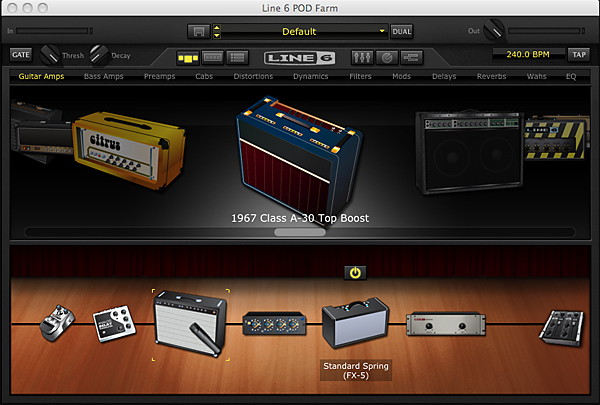
These are mostly based on real gear, including Marshall's JCM-800, Fender's Deluxe Reverb, and even the Orange AD30TC.
Pod farm line6 software#
POD Farm includes a stunning array of software models of amps, effects, and cabinets that you plug together in a very obvious signal chain on screen. The idea and many of the features are the same, but POD Farm has a much slicker interface. POD Farm replaces the former Gearbox software that used to be bundled with Line 6 interfaces. POD Farm is where the real second stage fun comes in. Considering this is stripped even further than the LE version, I'm not too interested in it.

I haven't played with Riffworks yet, and I already know that Ableton is a very cut-down version of that program, supposedly tailored to the hardware bundled with it. The POD Studio UX1 comes bundled with 3 programs: Riffworks T4, Ableton Live Lite 7 Line 6 Edition, and POD Farm. Running the same spectrographs on the signal from the UX1 yielded a much cleaner signal, with a slight noise level in the lowest extremes of the graph, but nothing audible and it was a steady baseline, so it essentially vanishes when you record. Line 6 boasts a greater than 100 dB signal to noise ratio, and I believe it. The UX1 suffers from NONE of those problems. If you read my review of the Lightsnake, you'll know it was a dirty, dirty interface, with odd pulses of interference and general noise.


Pod farm line6 driver#
This gives you effectively zero latency in the monitors, even if you have a relatively high latency setting in the ASIO driver itself.įrom my testing on an existing project, I have reduced the slips and stutters in my system from being a frequent occurrence to flawless audio by incorporating the UX1 into my setup.
Pod farm line6 Pc#
One admirable trait of the UX1 is that it is able to pass through the input audio to the output WITHOUT waiting for the PC to handle it directly. Latency? We Don't Need No Steenking Latency. With this, I don't really have to worry about upgrading that card, since I'm bypassing it for my audio work. In my case, I have a moderately cheap sound card in my PC. I have read where this can be confusing if you don't think about what you're doing, but it's a good thing. When I connected REAPER to the "ASIO UX1", then ALL of my audio output from REAPER was directed at the UX1. It comes with its own ASIO driver which you can easily tap into with most any audio software that supports ASIO. Oh, did I mention it functions as a complete sound interface, including output? That's right. The back of the unit has jacks for two 1/4" analog outputs, two 1/4" Line Inputs, one 1/4" Stereo Monitor line in, as well as the USB socket.Īs you might imagine, you can record from any of the inputs, except the Stereo Monitor line in - that acts as a pass-through for anything you want to show up in the mix but not be part of the "recordable" input. No big surprises in the function of each of those items. On top of the box are a power light and 2 knobs: Mic Gain and Output. On the front of the box, there are 3 ports one XLR jack, one 1/4" unbalanced instrument input, and a 1/4" headphone jack. The UX1 connects via USB, and all power is handled through the USB cable - no additional power supply needed.

To kick things off, let's look at the box itself. After playing with it for about a week, I think I've seen enough to give it a proper review. I can say now that the Lightsnake has been retired, and has been replaced with a Line 6 POD Studio UX1. If you've been reading here for a while, you know that my previous guitar recording interface, the Lightsnake, had some serious limitations and generally left me pretty unhappy with the results.


 0 kommentar(er)
0 kommentar(er)
